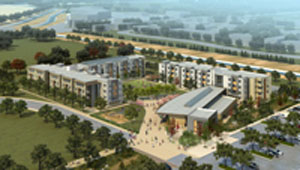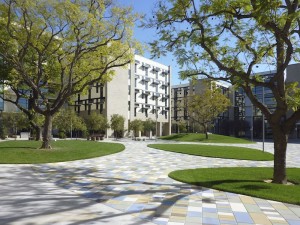By Erica Rascón on July 12, 2013 in News
This year’s student housing boom has opened the floodgates for innovation and creativity. Many recent and upcoming projects share common characteristics, paving the way for industry trends that will hold strong well beyond the coming year.
Growing Upward
This year, land prices have risen in major markets worldwide. Zelman and Associates reported that US land values raised an average of 13 percent in 2012; that growth has continued well into 2013. Even agricultural land prices have risen 15 percent according to The Federal Reserve Bank of Chicago. And as space adjacent to campuses becomes scarcer, renters can expect to see an increase of taller housing structures rather than extensive complexes, particularly near urban and infill campuses.
The recent return of vigor to the housing market has resulted in a lumber shortage, markedly driving up building costs. In an increasing number of cases, the cost of wood frames is nearing that of steel within 5 percent. If these conditions continue, builders may be even more motivated to pursue taller, land-conservative steel framed buildings, especially in urban cores.
The trend already has a solid foundation. University of Michigan students were greeted with high-rise accommodations on Southern University Avenue last year. 33-story The Grove at Cira Centre South is slated to sprout up near University Center, Philadelphia in coming months. University of Arizona opened a student housing high rise last year and will soon add another to the Tucson skyline next year.
Sustainable Here to Stay
The green living trend has sustained itself, finding its key supporters amongst youth and young adults. To appeal to coming generations, student housing developments have come to the forefront of green building, catering to an  audience that expects sustainability as a standard rather than a niche luxury. Many projects in the pipeline are aiming for top LEED certifications.
audience that expects sustainability as a standard rather than a niche luxury. Many projects in the pipeline are aiming for top LEED certifications.
California State University, Bakersfield (CUSB) will welcome a student housing complex suitable for 500 students. Living spaces will be dispersed amongst three four-story buildings, complete with chic lounges, games rooms, and study rooms. Features that help the site (pictured, left) achieve LEED Gold equivalency include high performance glazing on windows, sun shades, energy efficiency fixtures and appliances, low-flush toilets and solar-powered boilers.
 Western University has broken ground on a 173,000 square-foot mixed-use facility with housing for graduate students. Private and public collaboration funded this LEED Silver-certified living quarters that accommodates 306 beds with single and double occupancy options. Each bed will have a private bath, common area and en suite kitchen. The non-residential portion of the building includes a fitness center, pool, and interactive media room all with sustainable features.
Western University has broken ground on a 173,000 square-foot mixed-use facility with housing for graduate students. Private and public collaboration funded this LEED Silver-certified living quarters that accommodates 306 beds with single and double occupancy options. Each bed will have a private bath, common area and en suite kitchen. The non-residential portion of the building includes a fitness center, pool, and interactive media room all with sustainable features.
One can expect a domino effect as more universities embrace green housing: best practices surface; miscalculations and common mistakes become less common; in-demand materials are offered by more suppliers, and overall, sustainable student housing becomes easier to plan and build. California State University earned bragging rights as owners of the first LEED Platinum student housing community in the nation with Best Overall Sustainable Design honors. The building (left) boasts a slew of earth-friendly and money-saving features such as native landscaping, energy efficient glass and window systems, sunshades, an ultra-efficient HVAC system, energy efficient lighting, fixtures, and appliances and, to top it off the structure itself is composed of recycled concrete. Though it has been operable since fall of 2011, its new accolades have drawn fresh attention to the project, inspiring others in the industry.
Catering to the new generation is only part of the reason for the popularity of green building. The recent spike in building costs has many universities seeking ways to save money. Green buildings, with their low operation costs and increasingly affordable designs, are a viable alternative to traditional construction for cost-conscious schools.
Broader Horizons
As the workforce demands global –ready graduates, a greater number of students are seeking higher education outside of their homelands or supplementing their education with courses abroad. The SAGE Handbook on International High Education reveals an increased emphasis on international education and international exchange.
Student housing specialists are beginning to understand the impact of a diverse student body on college campuses as well as the potential for expanding their portfolios overseas. To reflect these interests, the Association of College Unions International (ACUI) recently hosted the International Study Tour: Arabian Gulf with stops in the United Arab Emirates and Qatar. Participants, mainly student housing and multifamily professionals, attended the ACUI conference before setting out to tour local campuses. The goal of the tour was to enhance participants’ understanding of higher education in the Arabian Gulf as well as gain a clearer vision of how to serve student populations from this region who are studying abroad. Participants hope to create housing in the US that is suitable for a diverse range of students. Many are also exploring the region as a possibility for future projects and collaborations.
What other emerging trends have you noticed in student housing projects in your area?


